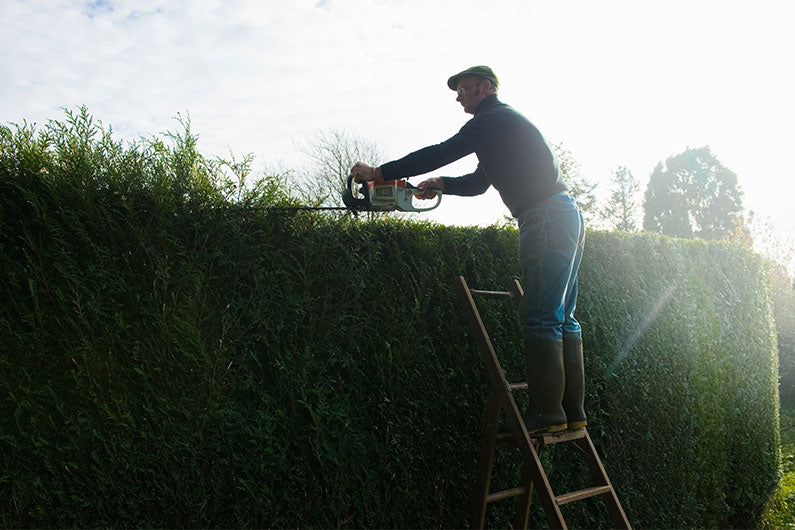
Care and Maintenance: When to Cut Leylandii Hedges
With their lush evergreen foliage and rapid growth, Leylandii hedges are a popular choice for creating privacy screens and boundaries in gardens and landscapes. This much-loved hybrid is an evergreen conifer developed from mixing two North American hedges, the Nootka cypress and the Monterey cypress.
Because they grow so quickly, it's essential to understand when it’s best to trim and prune these hedges to maintain them at their best. To stop your Leylandii from becoming wild and unruly, you should cut it at least once a year, and preferably twice if you want it to look really smart. The question is, when is the best time to cut a Leylandii?
This guide will help you determine the best time to cut Leylandii hedges and provide some essential tips to make the task easier and get the best results.
Understanding Leylandii Growth
Leylandii hedges can grow impressively fast, often adding three feet or more to their height in a single year. This can be both an advantage and a challenge for gardeners.
On one hand, you can get a beautiful hedge that provides ample screening for your garden in a short space of time; on the other hand, it can become messy without the right attention. This rapid growth makes frequent trimming necessary to maintain the hedge’s shape and density.
Understanding a Leylandii’s growth patterns is crucial to knowing when to trim them. You can learn more about this hedge variety in our complete guide to Leylandii hedges.

The Best Time to Cut Leylandii Hedges
The timing of hedge cutting can significantly impact the health and appearance of your Leylandii hedges. The best time to trim them depends on various factors which we’ve listed below.
Late Spring to Early Summer (May to June)
This period is generally considered the best time for the primary trim. Leylandii hedges are actively growing during late spring and early summer, which means they recover quickly after pruning. Trimming during this time encourages bushy, dense growth.
Late Summer (August to September)
If you missed the spring/early summer window or want to perform a light trim to maintain shape, late summer is a suitable time.
Avoid heavy pruning during this period, as it may not leave sufficient time for new growth to harden before winter.
Avoid Winter Trimming
Leylandii hedges should not be trimmed during the winter months. Cold temperatures and frozen ground can stress the plants, making them more susceptible to damage.
Additionally, winter trimming can lead to brown or dead foliage, as Leylandii cannot regrow effectively during this season.
Factors to Consider When Cutting Your Leylandii Hedges
When deciding the timing for cutting Leylandii hedges, consider the following factors:
Weather Conditions
Aim to trim when the weather is mild, and the ground is not frozen. Extreme heat or drought can stress the plants, so avoid trimming during heatwaves or extended dry spells.
Cutting your Leylandii while it’s windy or raining will also be impractical, and possibly even dangerous.
Desired Hedge Density
If you want a denser hedge, more frequent trimming during the growing season (late spring to early summer) will encourage branching and density. For a less dense hedge, trim less frequently.
Basic Tips for Cutting Leylandii Hedges
You can use shears to cut your Leylandii; however, an electric trimmer will help speed up the task and make it easier to create more definition in the shape of your hedge.
To ensure a safe and successful hedge-cutting experience, follow these basic tips:
Use Sharp Tools: Always use sharp tools to make clean cuts. Dull blades can damage the plants and leave them vulnerable to disease.
Trim Sparingly: Avoid cutting Leylandii hedges back to bare wood, as they may not recover. Instead, trim lightly, removing only the new growth to maintain shape.
Safety First: Wear appropriate safety gear, including gloves and eye protection, when trimming hedges. Be cautious of power lines if using electric tools.
Dispose of Clippings Properly: Dispose of hedge clippings responsibly, as they can be toxic to some animals. Composting or mulching the clippings is an eco-friendly option.
Regular Maintenance: Regularly monitor the growth of your Leylandii hedges and trim as needed to prevent them from becoming overgrown.
Be Aware of Wildlife: Birds and other animals often make their homes in hedges. Avoid cutting your Leylandii if there are bird’s nests. Instead, wait until nesting season ends.
Learn more about how to trim your hedges correctly with top tips from the experts.
Caring for Your Leylandii with Mathias Nurseries
By understanding Leylandii growth patterns and considering factors like timing, weather conditions, and desired density, you can maintain beautiful and healthy Leylandii hedges that enhance the aesthetics and privacy of your garden or landscape.
At Mathias Nurseries, we’re always here to provide you with expert advice on planting and maintaining your hedge. We are one of the largest growers of Leylandii hedges in the UK and it has consistently been one of our best sellers for decades so it is safe to say that we know a thing or two about this much loved hedging plant. We also stock a range of products to help you get the most out of your Leylandii.
Get in touch with us today if you have any questions or need advice about any of our products.
